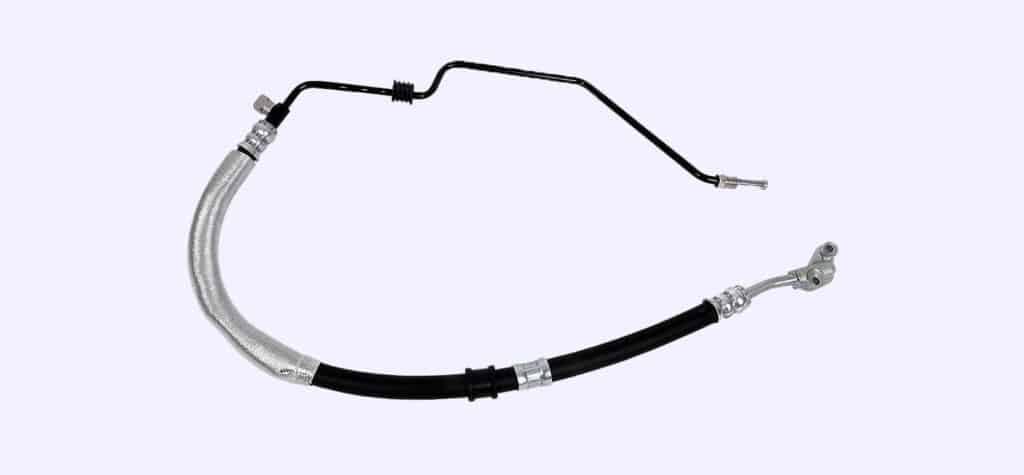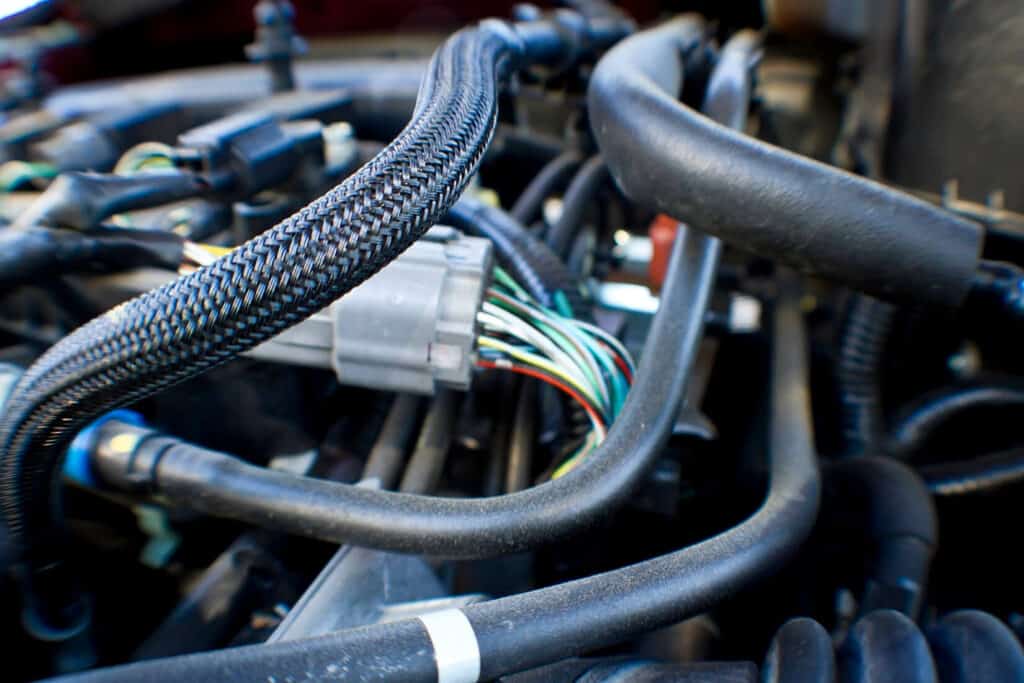Do you know that little-known component, the high-pressure hose assembly, plays a pivotal role in your vehicle’s hydraulic systems? These parts carry hydraulic fluid under high pressure from the pump to the other components, such as your power steering or brake system, and they do a heavy-duty job without much credit.
What is a High Pressure Hose Assembly?
High pressure hose assembly is a key player in a vehicle’s hydraulic systems, including power steering and braking systems. They are designed to transport hydraulic fluid under high pressure from the pump to the actuating mechanism. The “assembly” refers to the combination of the hose and its couplings, which together are capable of withstanding high pressure, heat, and sometimes corrosive hydraulic fluids.
How Much Will it Cost to Replace a High Pressure Hose Assembly in Canada?
The cost to replace a high-pressure hose assembly in Canada can range from $150 to $350 for parts, with labor costs adding another $100 to $200, depending on the complexity of the job. The labor could take between 1 to 2 hours. So, the total cost could range from $250 to $550. Note that the actual cost can vary based on the model of your vehicle and the rates of your chosen service center.

What are the Symptoms of a Faulty High Pressure Hose Assembly?
• Visible Damage or Leaks: This can include cracked, broken, or leaking hoses. You might also notice oil stains around the hose area.
• Poor Performance: If the high pressure hose assembly is failing, it may cause a noticeable decrease in the vehicle’s performance, such as slower acceleration.
• Unusual Noises: You may hear a whining or buzzing noise from the area where the high-pressure hose assembly is located.
• Warning Lights: The “Check Engine” or other system warning light might illuminate on your dashboard.
• Hard Steering: If the high pressure hose assembly is part of the power steering system and is faulty, it can cause the steering to become hard or unresponsive.
• Overheating: If the assembly is part of a cooling system, a faulty hose could lead to overheating of the engine.
How Long Does a High Pressure Hose Assembly Last?
High pressure hose assemblies are built to be sturdy, and they typically last between 60,000 to 100,000 kilometers. However, various factors can impact their lifespan, such as the type of vehicle, driving conditions, and maintenance habits.
How Does a High Pressure Hose Assembly Become Defective?
• Age and Wear: Over time, the high-pressure hose assembly can wear out, particularly if it’s exposed to extreme temperatures, causing the materials to break down and possibly leak.
• Physical Damage: The high-pressure hose assembly can become damaged due to accidents, road debris, or incorrect installation, leading to issues such as leaks or blockages.
• Corrosion: Chemical exposure or excessive moisture can lead to corrosion of the hose assembly over time, causing it to become defective.
• Vibration and Pressure: Constant vibration and high pressure from the vehicle’s operation can cause the hose assembly to crack or rupture, potentially causing a leak.
• Inferior Quality Parts: If the high-pressure hose assembly or its components are of poor quality, they may not last as long or perform as well, potentially leading to premature failure.
• Inadequate Maintenance: Failure to regularly check and maintain the high-pressure hose assembly could result in unnoticed damage or wear, leading to unexpected failure.
How Can a Faulty High Pressure Hose Assembly Affect the System?
• Loss of Hydraulic Fluid: A faulty high-pressure hose assembly can lead to a loss of hydraulic fluid. This could impair the functioning of systems that rely on this fluid, such as the power steering and brake systems.
• Poor Performance: The overall performance of your vehicle may decline due to decreased hydraulic pressure, potentially leading to a stiffer steering wheel or reduced brake effectiveness.
• Damage to Other Components: Hydraulic fluid leakage from a faulty hose assembly can contaminate other parts of the vehicle, leading to potential additional damage and repair costs.
• Overheating: A leak in the high-pressure hose assembly could result in insufficient hydraulic fluid, leading to overheating as the system works harder to compensate for the fluid loss.
• Increased Wear on the Pump: With less fluid in the system due to a leak, the hydraulic pump has to work harder, potentially leading to premature pump wear and failure.
• Increased Fuel Consumption: As the vehicle’s systems have to work harder due to reduced hydraulic pressure, there may be an increase in fuel consumption.
Is it Safe to Drive with a Faulty High Pressure Hose Assembly?
Can you afford to take chances when driving with a faulty high-pressure hose assembly? This crucial component of your vehicle’s hydraulic system might seem inconsequential, but its failure can compromise your vehicle’s safety and performance. A defective high-pressure hose assembly could lead to a loss of hydraulic pressure, which directly impacts the operation of your vehicle’s power steering and brakes. This means that you might struggle with steering or stopping your vehicle, increasing the risk of accidents. The immediate answer, therefore, is no – it’s not safe to drive with a faulty high-pressure hose assembly.

In addition to these serious safety concerns, driving with a faulty high-pressure hose assembly can also cause additional damage to your vehicle. Leaking hydraulic fluid can contaminate other components, leading to more extensive repairs in the future. Also, the persistent low fluid level due to leakage can cause the hydraulic pump to overwork, shortening its lifespan. So, not only is it unsafe, but it can also be more costly in the long run. Prioritizing high-pressure hose assembly repairs ensures you stay safe on the road and potentially saves you from more costly repairs down the line.
How Can I Make My High Pressure Hose Assembly Last Longer?
• Regularly check for signs of wear or damage
• Ensure that the hydraulic fluid is clean and at the correct level
• Avoid extreme driving conditions that cause high heat and pressure
• Get regular inspections by a professional mechanic
Can a Mobile Mechanic Replace a High Pressure Hose Assembly?
Yes, many mobile mechanics are equipped and trained to replace high-pressure hose assemblies. They can perform this task at your home or office, providing convenience and saving you valuable time.
Conclusion: High Pressure Hose Assembly Replacement
Replacing your high-pressure hose assembly is crucial to maintain the performance and safety of your vehicle’s hydraulic systems. It might not be the most glamorous component, but its role is fundamental. Remember, the health of your vehicle depends on the sum of its parts, and every part deserves your attention. Regular checkups and maintenance can ensure longevity and safer rides. So, treat your high-pressure hose assembly with the care it deserves, and it’ll pay you back with reliable service.
Next Steps
Book Your Fuel Pump Replacement Service
The service most frequently booked by those who read this article is Fuel Pump Replacement. Uchanics’ expert technicians make the process even more convenient by bringing the service right to your doorstep. We perform this job at your home or office, covering over 40 cities in Ontario, including Oshawa, Ajax, Toronto, Scarborough, Mississauga, Brampton, and more. Our commitment to excellence has earned us more than 700 glowing 5-star reviews. Choose Uchanics for your Fuel Pump Replacement and experience unparalleled convenience and top-quality service.
